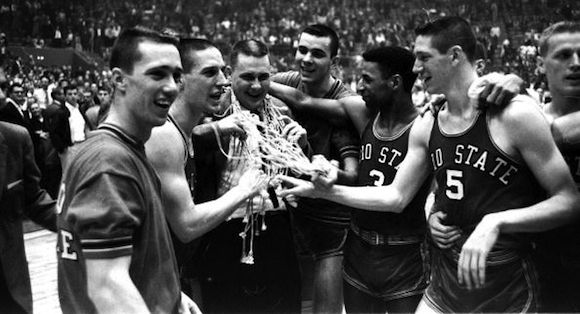As the only team in Ohio State history to win a national championship, the 1959–60 Ohio State Buckeyes men’s basketball team has an unrivaled heritage.
The 1959–60 Ohio State Buckeyes men’s basketball team holds a unique and revered place in Ohio State sports history, a team that has come to symbolize the pinnacle of collegiate basketball success in Columbus, Ohio. As the only squad to ever win a national championship in men’s basketball for the Buckeyes, their achievement stands not only as a monumental feat in the university’s athletic history but also as a defining chapter in the annals of NCAA basketball. This team, led by an extraordinary combination of coaching brilliance, youthful talent, and unwavering chemistry, set a standard that has yet to be matched by any other Ohio State basketball team, immortalizing their names in both the school’s and the sport’s storied history.
The 1959–60 season began with modest expectations for the Buckeyes, but it quickly evolved into something extraordinary. Coached by Fred Taylor, who was in just his second year as head coach, the team featured a core of young, highly skilled players who brought a new level of energy and strategy to the court. Taylor, who would eventually be inducted into the Naismith Memorial Basketball Hall of Fame, was instrumental in shaping the team’s philosophy of unselfish play, crisp ball movement, and relentless defense. He brought a disciplined, team-first mentality to the squad that was crucial to their success.
At the center of this championship-caliber team was Jerry Lucas, a sophomore forward whose dominant play throughout the season earned him national recognition. Lucas, known for his exceptional rebounding, pinpoint passing, and efficient scoring, was not only the team’s best player but also one of the greatest college basketball players of all time. He led the team in scoring and rebounding, establishing himself as the cornerstone of Ohio State’s frontcourt. Lucas’s presence in the paint gave the Buckeyes a distinct advantage, and his high basketball IQ enabled him to anticipate plays and dictate the tempo of the game.
Complementing Lucas was another key figure: John Havlicek, a versatile and athletic swingman who would later become an NBA legend with the Boston Celtics. Havlicek’s role on the 1959–60 team was less about dominating the scoreboard and more about doing everything else at a high level. His ability to defend multiple positions, rebound, and contribute offensively when needed made him an invaluable asset. Alongside Lucas and Havlicek was point guard Larry Siegfried, a senior leader who brought poise, experience, and stability to the backcourt. Siegfried was known for his calm demeanor under pressure and his ability to facilitate the offense effectively.
The team’s chemistry was evident in their playing style. They emphasized unselfishness, often passing up good shots for great ones, and their high shooting percentage was a testament to their disciplined approach. Defensively, they were suffocating, often stifling opponents with intense man-to-man coverage and smart positioning. The Buckeyes were relentless on the boards, thanks in large part to Lucas’s rebounding prowess, which consistently limited opponents’ second-chance opportunities.
Ohio State’s dominance during the regular season was clear as they cruised to a 25–3 record. They went undefeated in Big Ten play, finishing 13–1 in the conference, and entered the NCAA tournament as one of the favorites. In an era before the expanded tournament formats of today, the NCAA field was much smaller, and the road to the championship was more direct but equally grueling. The Buckeyes dispatched their early-round opponents with ease, showcasing their blend of athleticism, teamwork, and strategy.
One of the defining characteristics of this team was their ability to rise to the occasion in big moments. As they progressed through the NCAA tournament, the stakes grew higher, but so did their level of play. In the Final Four, held in San Francisco, Ohio State faced off against the University of California, the defending national champions. The Buckeyes’ performance in this game was nothing short of masterful. They controlled the pace, executed their game plan flawlessly, and shut down California’s offensive options. Jerry Lucas’s dominance on the boards and Havlicek’s defensive intensity were on full display as Ohio State triumphed, earning a spot in the national championship game.
In the title game, the Buckeyes faced the University of California, and it proved to be a one-sided affair. Ohio State’s superior depth, skill, and preparation overwhelmed their opponents as they secured a resounding 75–55 victory to claim the national championship. Jerry Lucas scored 16 points and grabbed 10 rebounds, once again leading the team on both ends of the court. It was a comprehensive win that reflected the team’s balance and cohesion, with six players scoring in double figures. The magnitude of this victory cannot be overstated. It was the culmination of months of dedication, teamwork, and belief, and it established the 1959–60 team as the greatest in Ohio State basketball history.
Beyond the statistics and accolades, what truly set this team apart was its lasting impact. The 1959–60 Buckeyes set a benchmark for excellence, not just within their program but across college basketball. They were innovators in the way they moved the ball and shared the scoring load, and their defensive tenacity became a model for future teams. Individually, many of the players went on to have distinguished professional careers, most notably John Havlicek, who became an NBA Hall of Famer, and Jerry Lucas, who would also be enshrined in the Hall of Fame and earn NBA All-Star honors.
Coach Fred Taylor’s influence also extended well beyond that championship season. He went on to coach at Ohio State for over a decade, building on the foundation of success he had established. While he never again reached the ultimate heights of 1960, he consistently fielded competitive teams and became one of the most respected figures in college basketball. His mentorship of players and commitment to the values of hard work, integrity, and teamwork left a lasting legacy at the university.
Despite subsequent appearances in the Final Four, including back-to-back trips in 1961 and 1962 with many of the same core players, Ohio State has never again captured the national title in men’s basketball. This only enhances the mystique of the 1959–60 squad. They remain the lone national champions in school history, a singular achievement that continues to be celebrated by fans and alumni. Their legacy is woven into the fabric of Ohio State athletics, a golden moment that stands tall among the school’s many sporting accomplishments.
In many ways, the story of the 1959–60 Buckeyes is also a reflection of a different era in college basketball, when players often stayed in school for multiple years, teams were built around continuity and development, and coaches had long tenures to shape their programs. This was a time before one-and-done players, before televised national recruiting battles, and before the commercial explosion of March Madness. Yet the values that defined this team—teamwork, sacrifice, preparation, and execution—remain timeless. They would be just as effective and commendable in today’s game as they were over six decades ago.
The reverence with which the 1959–60 team is remembered speaks to the enduring nature of their accomplishment. Every time Ohio State takes the floor at Value City Arena, every time a Buckeye player dons the scarlet and gray, they are walking in the footsteps of legends. The shadow cast by that championship team is long, but it is a source of pride and inspiration, not pressure. It reminds everyone affiliated with the program of what is possible when talent, leadership, and commitment align perfectly.
Over the years, the team has been honored in various ways, including reunions, commemorative displays, and the induction of individual members into halls of fame. Yet perhaps the greatest tribute is the simple fact that their story continues to be told. It is passed down from generation to generation, not just as a tale of victory, but as a lesson in excellence. For Ohio State fans, the 1959–60 Buckeyes are more than just a basketball team—they are a symbol of greatness, a reminder that championships are earned through unity, grit, and determination.
In the ever-evolving landscape of college basketball, where success can be fleeting and dynasties come and go, the 1959–60 Ohio State Buckeyes stand as a beacon of enduring excellence. Their national championship remains a singular achievement in the history of the university’s men’s basketball program, unmatched by any other team before or since. As such, they hold a unique and cherished place in Ohio State history, a testament to what can be achieved when extraordinary talent meets extraordinary will. Their story is not just a chapter in Ohio State’s past—it is a legacy that continues to inspire the future.



